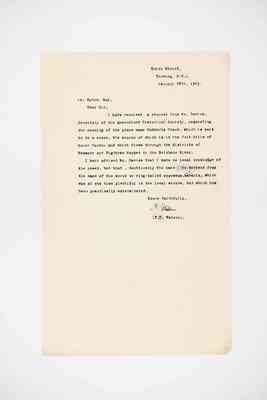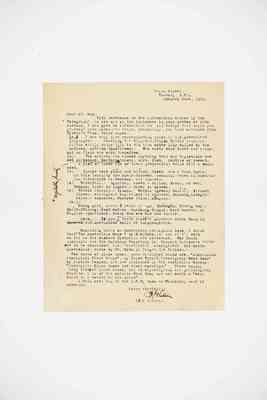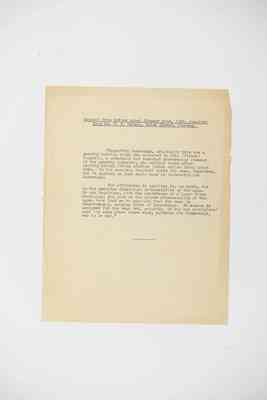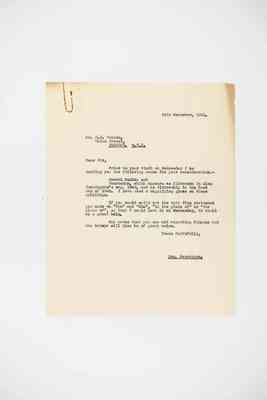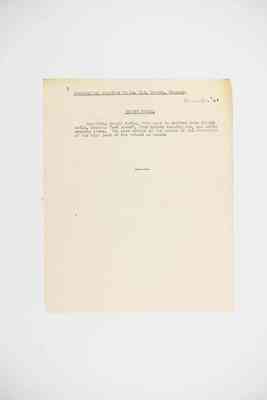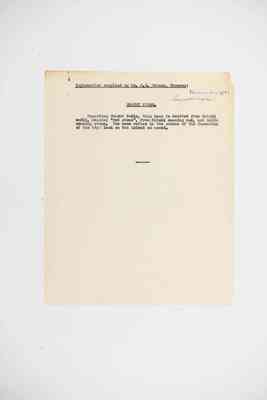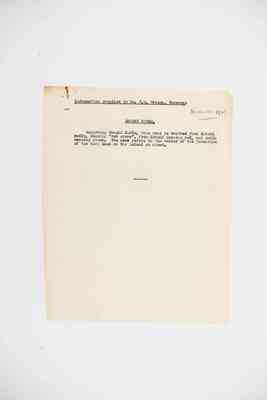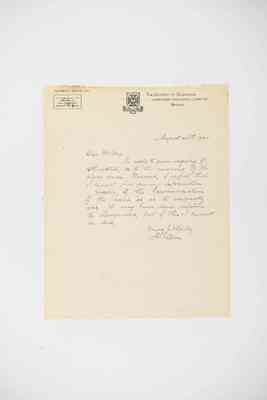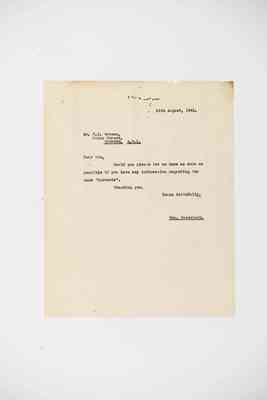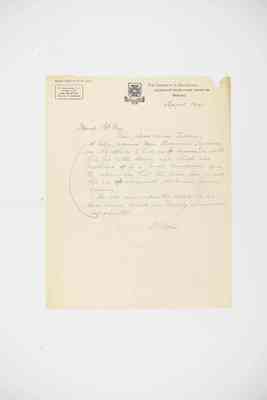Pages That Need Review
Correspondence Between Sydney May And F.J Watson Concerning Aboriginal Place Names (ITM489477)
21
Union Street, Toowong, S. W. 1. January 28th, 1943.
Mr. Sydney May,
Dear Sir,
I have received a request from Mr. Davies, Secretary of the Queensland Historical Society, requesting the meaning of the place name Cubberla Creek, which is said to be a creek, the source of which is in the foot hills of Mount Cootha and which flows through the districts of Kenmore and Fig-tree Pocket to the Brisbane River.
I have advised Mr. Davies that I have no local knowledge of the creek, but that, doubtlessly the name is derived from the name of the scrub or ring-tailed oppossum, kâ'bārla, which was at one time plentiful in the local scrubs, but which has been practically exterminated.
Yours faithfully, [signature] (F. J. Watson).
22
Union Street, Toowong, S.W.1. January 22nd, 1943.
Dear Mr. May,
With reference to the information wanted by the "Telegraph" as set out on the inclosure in your letter of 20th instant, I can give no information on (1) except that which you yourself have noted, and which, presumably, you have obtained from Tyrrel's "Abc. Place names.
No. 2 I can only give corresponding names in S.E. Queensland languages. Choosing the Yugumbir, (Logan River) language, (a) One edible water lily is the blue water lily called by the natives, mū-'-ūm (mee-'-i-oom). The roots were baked and eaten, but no flour was made therefrom.
(b). The natives ate almost anything that was digestible and not poisonous, whether vegetables, fruit, animal, bird, fish, reptile or insect.
A list of foods and of their preparation would fill a small book.
(c). Spears were guńai and bilara, dheen was a fish spear, in this locality the spear-thrower, commonly known in Australian literature is woomera, was unknown.
(d) Waterfall, - ngulara;, creek - ballum; ocean, or sea, tumgun; lake - or lagcen, - nanda or nyanda.
(e) Wattle (black), - tyumau; Wattle (green) dhaí-ī; Flannel flower, aboriginal equivalent is unknown; Banksia, integrifolia, - bumbarra; Gumtree (blue) mūngara.
No. 3.
Young girl, under 8 years of age, dhábūgun; Strong boy, - dha'bū-bullang; Good mother, waidhung-baugul; Good hunter, no English equivalent, every man was his own hunter.
Note. To apply these names to anywhere other than in than in S.E. Queensland would be inappropriate.
Regarding books on Australian aboriginal lore, I think that "The Australian Race" by E.M. Curr, is one of the best as far as the Eastern Districts are concerned. For South Australia and the Northern Territory Dr. Herbert Basedow's works are to be commended, i.e. "Australian Aborigines", For North Queensland, words by Dr. Roth. (I forget the titles).
For books of place names, some published works are, "Australian Aboriginal Place Names", by James Tyrril; "Aboriginal Word Book" by Justine Kenyen; and one published by the Australian Museum, "Australian Place Names and their meanings". These supply long lists of place names, but, as etymological and philological studies, I am of the opinion that they are not worth a "weir built by a worker in tin plate".
I will meet you at the Q.P.N. room on Wednesday next if possible.
Yours faithfully, [signature] (F. J. Watson).
23
Extract from letter dated January 22nd, 1943, received from Mr. F. J. Watson, Union Street, Toowong.
"Regarding Tamrookum, originally this was a grazing holding which was selected by John (Tinker) Campbell, a prominent and somewhat picturesque pioneer of the grazing industry, who settled there after leaving Kittah Kittah station (later called Bebo) about 1842. In his memoirs, Campbell spelt the name, Tamrookum, but it appears on some early maps as Ginbrookin and Janbrakin.
The difference in spelling is, no doubt, due to the peculiar aboriginal pronunciation of the name. My own inquiries, with the assistance of a Logan River aborigine, who gave me the proper pronunciation of the name, have lead me to conclude that the name is Dhan-burugun, meaning place of boomerangs. No reason is assigned for the name but, probably, it was the aborigines' name for some place where wood, suitable for boomerangs, was to be had."
24
24th November, 1941.
Mr. F.J. Watson, Union Street, TOOWONG. S.W.1.
Dear Sir,
Prior to your visit on Wednesday I am sending you the following names for your consideration: -
Coochi Mudlo; and Tamrookum, which appears as Jinbroken in Alan Cunningham's map, 1829, and as Ginbrookin in the land map of 1848. I have used a magnifying glass on these spellings.
If you would write out the very fine statement you made on "Tya" and "dha", "in the place of" or "the place of", so that I could have it on Wednesday, it would be a great help.
Any notes that you can add regarding Pimpama and the Laheys will also be of great value.
Yours faithfully,
Hon. Secretary.
25
Information supplied by Mr. F.J. Watson, Toowong;
November '41
COOCHI MUDLO.
Regarding Coochi Mudlo, this name is derived from Kutchi mudlu, meaning "red stone", from Kutchi meaning red, and mudlu meaning stone. The name refers to the colour of the formation of the high land on the island so named.
26
Information supplied by Mr. F.J. Watson, Toowong:
November 1941 August 1941
COOCHI MUDLO.
Regarding Coochi Mudlo, this name is deried from Kutchi mudlu, meaning "red stone", from Kutchi meaning red, and mudlu meaning stone. The name refers to the colour of the formation of the high land on the island so named.
27
Information supplied by Mr. F. J. Watson, Toowong:
[COOCHI MUDLO].
Regarding [Coochi Mudlo], this name is derived from Kutchi mudlu, meaning "red stone", from Kutchi meaning red, and mudlu meaning stone. The name refers to the colour of the formation of the high land on the island so named.
[right margin] November 1841 --------------------
28
[left margin] TELEPHONE: B 2501 (5 Lines)
All communications to be addressed to the HON. SECRETARY, University of Queensland.
[coat of arms] Scientia ac labore
THE UNIVERSITY OF QUEENSLAND, QUEENSLAND PLACE NAMES COMMITTEE. BRISBANE.
August 20th 1941.
Dear [Mr. May],
In reply to your inquiry, of 15th instant, as to the meaning of the place name [Murarie], I regret that I cannot give you any information.
Possibly, if the pronunciation of the name is as it originally was, it may have some relation to Kangaroos, but of this I cannot be sure,
Yours faithfully [FJ Watson]
30
[left margin] TELEPHONE: B 2501 (5 Lines)
All communications to be addressed to the HON. SECRETARY, University of Queensland.
[coat of arms] Scientia ac labore
THE UNIVERSITY OF QUEENSLAND, QUEENSLAND PLACE NAMES COMMITTEE. BRISBANE.
August 1941
Memo [Mr May].
Re. place name "[Tirroan].
A letter, received from Tasmania, by some one who appears to had early [connexion?] with Gin Gin Cattle Station, and which was published of by a local Newspaper, gave the informtion that this place was named after an [afr?] aboriginal stockman name [Diroan],
(The abo. was evidently called by his class name, which was locally pronounced [Turro-in?]) [FJW]
[FJ Watson]
